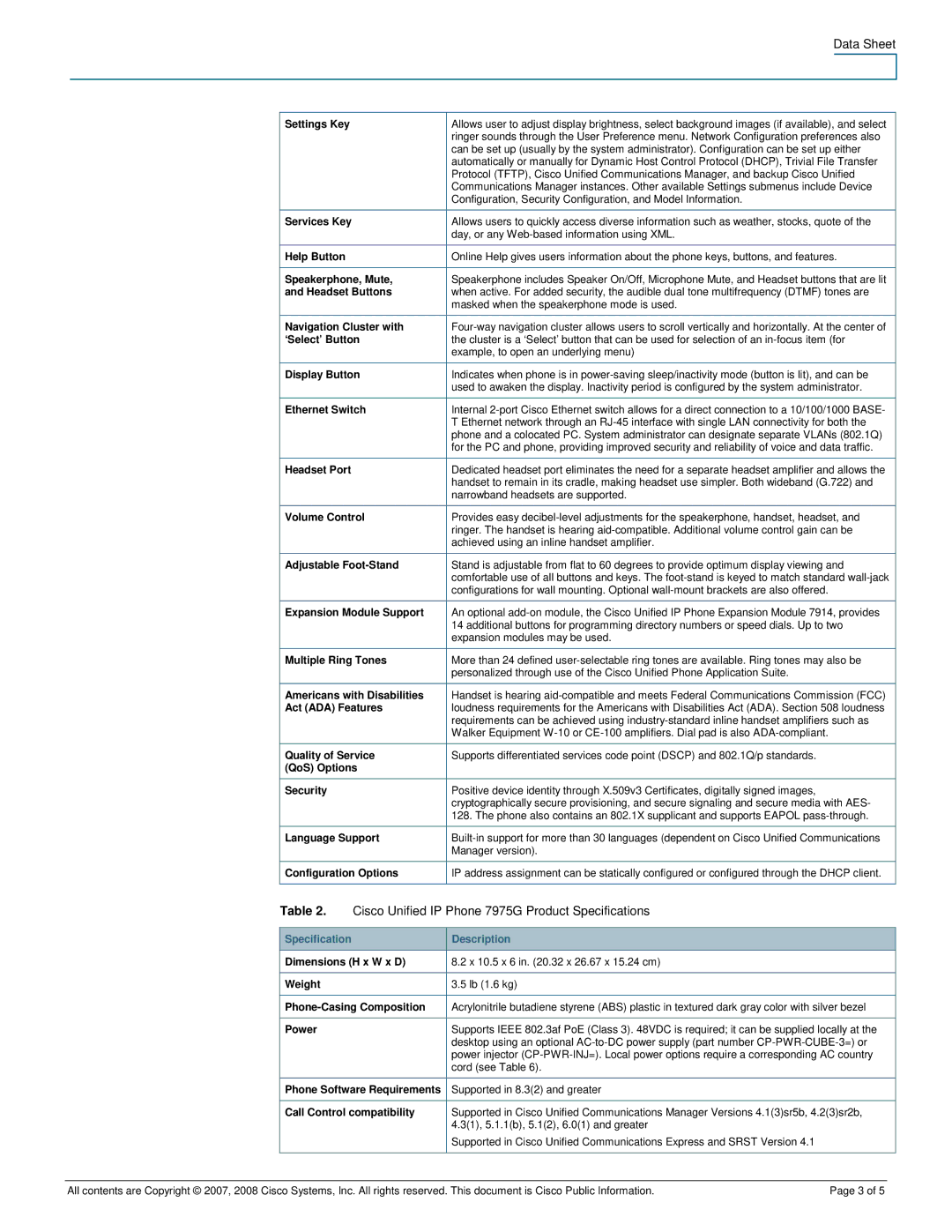
Data Sheet
Settings Key | Allows user to adjust display brightness, select background images (if available), and select |
| ringer sounds through the User Preference menu. Network Configuration preferences also |
| can be set up (usually by the system administrator). Configuration can be set up either |
| automatically or manually for Dynamic Host Control Protocol (DHCP), Trivial File Transfer |
| Protocol (TFTP), Cisco Unified Communications Manager, and backup Cisco Unified |
| Communications Manager instances. Other available Settings submenus include Device |
| Configuration, Security Configuration, and Model Information. |
|
|
Services Key | Allows users to quickly access diverse information such as weather, stocks, quote of the |
| day, or any |
|
|
Help Button | Online Help gives users information about the phone keys, buttons, and features. |
|
|
Speakerphone, Mute, | Speakerphone includes Speaker On/Off, Microphone Mute, and Headset buttons that are lit |
and Headset Buttons | when active. For added security, the audible dual tone multifrequency (DTMF) tones are |
| masked when the speakerphone mode is used. |
|
|
Navigation Cluster with | |
‘Select’ Button | the cluster is a ‘Select’ button that can be used for selection of an |
| example, to open an underlying menu) |
|
|
Display Button | Indicates when phone is in |
| used to awaken the display. Inactivity period is configured by the system administrator. |
|
|
Ethernet Switch | Internal |
| T Ethernet network through an |
| phone and a colocated PC. System administrator can designate separate VLANs (802.1Q) |
| for the PC and phone, providing improved security and reliability of voice and data traffic. |
|
|
Headset Port | Dedicated headset port eliminates the need for a separate headset amplifier and allows the |
| handset to remain in its cradle, making headset use simpler. Both wideband (G.722) and |
| narrowband headsets are supported. |
|
|
Volume Control | Provides easy |
| ringer. The handset is hearing |
| achieved using an inline handset amplifier. |
|
|
Adjustable | Stand is adjustable from flat to 60 degrees to provide optimum display viewing and |
| comfortable use of all buttons and keys. The |
| configurations for wall mounting. Optional |
|
|
Expansion Module Support | An optional |
| 14 additional buttons for programming directory numbers or speed dials. Up to two |
| expansion modules may be used. |
|
|
Multiple Ring Tones | More than 24 defined |
| personalized through use of the Cisco Unified Phone Application Suite. |
|
|
Americans with Disabilities | Handset is hearing |
Act (ADA) Features | loudness requirements for the Americans with Disabilities Act (ADA). Section 508 loudness |
| requirements can be achieved using |
| Walker Equipment |
|
|
Quality of Service | Supports differentiated services code point (DSCP) and 802.1Q/p standards. |
(QoS) Options |
|
|
|
Security | Positive device identity through X.509v3 Certificates, digitally signed images, |
| cryptographically secure provisioning, and secure signaling and secure media with AES- |
| 128. The phone also contains an 802.1X supplicant and supports EAPOL |
|
|
Language Support | |
| Manager version). |
|
|
Configuration Options | IP address assignment can be statically configured or configured through the DHCP client. |
|
|
Table 2. | Cisco Unified IP Phone 7975G Product Specifications | |
|
|
|
Specification |
| Description |
|
| |
Dimensions (H x W x D) | 8.2 x 10.5 x 6 in. (20.32 x 26.67 x 15.24 cm) | |
|
|
|
Weight |
| 3.5 lb (1.6 kg) |
|
| |
Acrylonitrile butadiene styrene (ABS) plastic in textured dark gray color with silver bezel | ||
|
|
|
Power |
| Supports IEEE 802.3af PoE (Class 3). 48VDC is required; it can be supplied locally at the |
|
| desktop using an optional |
|
| power injector |
|
| cord (see Table 6). |
|
| |
Phone Software Requirements | Supported in 8.3(2) and greater | |
|
| |
Call Control compatibility | Supported in Cisco Unified Communications Manager Versions 4.1(3)sr5b, 4.2(3)sr2b, | |
|
| 4.3(1), 5.1.1(b), 5.1(2), 6.0(1) and greater |
|
| Supported in Cisco Unified Communications Express and SRST Version 4.1 |
|
|
|
All contents are Copyright © 2007, 2008 Cisco Systems, Inc. All rights reserved. This document is Cisco Public Information. | Page 3 of 5 |
